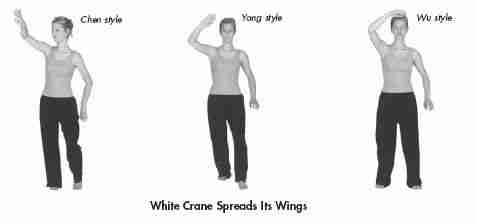Tai Chi Styles for Beginners: Differences and History
Four major tai chi family styles are the Chen, Yang, Wu , and Hao styles . The fifth major tai chi style is actually a group of styles known as Combination styles. These combine elements from different tai chi styles and may include movements from other martial arts forms.
Each of the tai chi styles executes movements slightly differently than the others. You can see this in the diagram below, where the same movement is shown from the Chen, Yang, and Wu tai chi styles.

1. The Chen style is characterized by alternating slow and explosive movements. It can be difficult for beginners because of the complex movements and physical coordination required. Read more about the first known tai chi style, the Chen.
2. The Yang style was derived from the Chen tai chi style. Although not the oldest, it is the most popular and widely practiced style today. Find out more about the popular Yang style.
3. The Wu tai chi style is a third generation style, derived from the Yang. Read about the Wu tai chi style here.
4. The Hao style. Because this style does not have many practitioners, even in China, it will not be discussed further here.
5. Combination Styles are actually made up of a number of schools. Each brings its own unique mix of tai chi movements with moves from other martial arts.
In addition, read about:
• Criteria to analyze tai chi style differences: tempo and framesize
• History and evolution of the different tai chi styles
Tai Chi Style Differences. Two simple criteria for describing styles are: tempo or speed, and how expansive the movements are, or frame size. Click here for a direct comparison of the Chen, Yang, and Wu styles in terms of tempo and frame size.
Other, less easily observed criteria include: whether the feet are parallel, weight distribution in stances, and how the elbows are used.
Different Styles, Different Flavors. The health benefits and martial arts techniques are bundled into the Chen, Yang, and Wu tai chi styles. From that standpoint, it doesn’t matter which style you practice. They’re just different flavors of this very rich, multi-faceted art.
Combination Styles. Combination styles mix and match movements from the Chen, Yang, and Wu tai chi styles along with those from other internal martial arts. Some combination styles have even used elements from kung fu and wrestling. Combination styles known in the West include the Sun style and Fu style. Western Styles. A number of Western or nontraditional styles of tai chi have also been developed, but they simplify the principles of body alignments and energy mechanics—and yield fewer or less profound benefits to practitioners.
Evolution of the Tai Chi Styles. Differences between the various tai chi styles can be largely explained in terms of the style history and origin.
The Chen is the first known tai chi style. The Yang is a second generation style, derived from the Chen. The Wu is a third generation style, derived from the Yang style. Western styles are the most recent tai chi styles.
Read more details about the history and evolution of the different tai chi styles here.
Next: Read about tai chi style trademarks and differences.
Top
